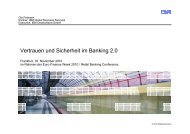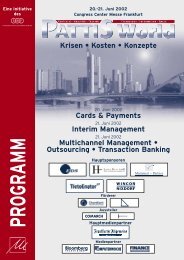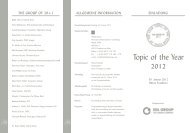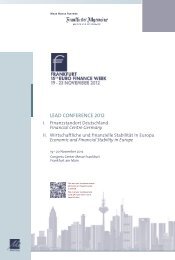Implications of Basel III for the European banking sector
Implications of Basel III for the European banking sector
Implications of Basel III for the European banking sector
You also want an ePaper? Increase the reach of your titles
YUMPU automatically turns print PDFs into web optimized ePapers that Google loves.
<strong>Implications</strong> <strong>of</strong> <strong>Basel</strong> <strong>III</strong> <strong>for</strong> <strong>the</strong><br />
<strong>European</strong> <strong>banking</strong> <strong>sector</strong><br />
Euro Finance Week 2011<br />
Frankfurt<br />
November 14, 2011<br />
CONFIDENTIAL AND PROPRIETARY<br />
Any use <strong>of</strong> this material without specific permission <strong>of</strong> McKinsey & Company is strictly prohibited
Current context <strong>of</strong> financial regulation and risk management in <strong>banking</strong><br />
CDS spreads sovereign bonds, bps<br />
6,000<br />
5,500<br />
5,000<br />
4,500<br />
4,000<br />
3,500<br />
3,000<br />
2,500<br />
2,000<br />
1,500<br />
1,000<br />
500<br />
0<br />
2009 2010 2011<br />
Europ. Banks<br />
- MtB ~0.9 ~0.7 ~0.5<br />
- CDS (bps) ~120 ~320 ~470<br />
1 <strong>European</strong> Banks ex UK<br />
2 5 yr spreads, <strong>European</strong> banks<br />
SOURCE: Datastream<br />
Greece<br />
Portugal<br />
Ireland<br />
Italy<br />
Spain<br />
▪ Significant volatility in<br />
<strong>the</strong> financial markets;<br />
liquidity markets drying up<br />
▪ Short-term capitalization<br />
requirements from<br />
EBA stress testing vs.<br />
depressed bank equity<br />
valuation levels<br />
▪ Significant risks <strong>of</strong> an<br />
economic downturn<br />
▪ Longer-term regulatory<br />
re<strong>for</strong>ms and business<br />
trans<strong>for</strong>mation in banks<br />
and market structure<br />
changes overall in <strong>the</strong><br />
financial services industry<br />
McKinsey & Company | 1
New regulatory regime will <strong>for</strong>ce significant capital and liquidity shortfall<br />
<strong>for</strong> Europe and U.S. financial institutions<br />
EUR billions; 2019<br />
<strong>European</strong> U.S.<br />
~ € 750 billion<br />
<strong>of</strong> common<br />
equity shortfall<br />
1,050<br />
Capital<br />
1,300<br />
Shortterm<br />
liquidity<br />
2,300<br />
Longterm<br />
funding<br />
SOURCE: McKinsey <strong>Basel</strong> <strong>III</strong> Impact Assessments <strong>European</strong> and US Banks, Nov. 2010<br />
600<br />
Capital<br />
600<br />
Shortterm<br />
liquidity<br />
2,200<br />
Longterm<br />
funding<br />
McKinsey & Company | 2
After implementation <strong>of</strong> <strong>Basel</strong> <strong>III</strong> regulatory measures, ROE <strong>of</strong><br />
global banks could decrease by 3-4 pp be<strong>for</strong>e mitigation<br />
Percent; expected pre-tax ROE<br />
Without<br />
regulation 2<br />
Capital<br />
requirements<br />
Liquidity/<br />
funding<br />
With<br />
regulation<br />
Capital quality/<br />
deduction<br />
RWA (market risk<br />
and credit risk)<br />
Capital ratios<br />
Leverage ratio 3<br />
Liquidity (LCR)<br />
<strong>European</strong> banks 1<br />
Funding (NSFR) 0.6<br />
0.7 ▪ Introduction <strong>of</strong> NSFR in 2018<br />
10.7<br />
-4.3<br />
1 Sample includes ~45 banks across Europe<br />
2 EU: based on 2004-07 ROE <strong>for</strong> individual banks scaled down to average 1980-2008 levels across EU<br />
3 Only additional capital need (after increase <strong>of</strong> minimum capital ratio and capital deductions) considered<br />
1.3<br />
1.3<br />
0.1<br />
0.2<br />
0.8<br />
15.0<br />
SOURCE: McKinsey <strong>Basel</strong> <strong>III</strong> Impact Assessments <strong>European</strong> and US Banks, Nov. 2010<br />
U.S. average<br />
0.8<br />
0.7<br />
0.7<br />
0.3<br />
0<br />
8.9<br />
12.1<br />
-3.2<br />
Main drivers<br />
ESTIMATES<br />
BEFORE<br />
MITIGATION<br />
▪ Limited recognition <strong>of</strong> DTAs<br />
and minority interest<br />
▪ Significant increase in market<br />
risk and CCR RWA<br />
▪ Common equity and Tier 1<br />
target ratios set at 9 and 11%<br />
▪ Additional capital need from<br />
leverage ratio constraint<br />
▪ Introduction <strong>of</strong> LCR in 2015<br />
▪ Impact after phase-in <strong>of</strong><br />
full <strong>Basel</strong> <strong>III</strong> requirements –<br />
be<strong>for</strong>e mitigating actions<br />
McKinsey & Company | 3
Resulting impact on <strong>the</strong> financial and <strong>banking</strong> market structure:<br />
what trends we do expect?<br />
1<br />
2<br />
3<br />
4<br />
Significant repricing <strong>of</strong> <strong>banking</strong> products – though<br />
timing given <strong>the</strong> different competitive positions unclear<br />
Disintermediation and more direct capital transfer<br />
between Corporates and Investors (insurances, funds etc.)<br />
New structure <strong>for</strong> banks’ capital and funding markets<br />
(secured funding, collateral management)<br />
Continued deleveraging/derisking <strong>of</strong> banks’ balance<br />
sheets and an increase in non-bank/shadow <strong>banking</strong><br />
activities<br />
McKinsey & Company | 4
1<br />
<strong>Basel</strong> <strong>III</strong> will significantly change product costs<br />
bps<br />
Products<br />
Retail<br />
<strong>banking</strong><br />
Corporate<br />
<strong>banking</strong><br />
Trading<br />
book<br />
securities<br />
Offbalance<br />
sheet<br />
▪ ST Retail loans<br />
▪ Residential mortgages<br />
< 35% risk weight<br />
▪ O<strong>the</strong>r mortgages<br />
▪ ST Corporate loans<br />
▪ LT Corporate loans<br />
▪ Specialized lending<br />
▪ Government bonds<br />
▪ Corporate or covered bonds > AA-<br />
▪ Corporate or covered bonds A-<br />
▪ Bonds < A- (or unrated)<br />
▪ Financial Institution bonds<br />
▪ OTC derivatives (relative to market<br />
value/current exposure)<br />
▪ Corporate credit lines (non-FI)<br />
▪ Corporate liquidity lines (non-FI)<br />
▪ FI credit and liquidity lines<br />
∆ Capital cost 1 ∆ Liquidity cost 2<br />
20<br />
15<br />
15<br />
15<br />
15<br />
15<br />
25<br />
30<br />
30<br />
30<br />
25<br />
25<br />
50<br />
60<br />
55<br />
∆ Funding cost 3 ∆ Total<br />
1 Assuming target Tier 1 ratio <strong>of</strong> 8% under <strong>Basel</strong> II and 11% under <strong>Basel</strong> <strong>III</strong>; in addition, 20% increase to account <strong>for</strong> capital quality and deductions measures<br />
2 Introduction <strong>of</strong> LCR in 2014; assuming current liability structure and 7% liquidity holding per product under <strong>Basel</strong> II and 105% LCR target ratio under <strong>Basel</strong> <strong>III</strong><br />
3 Introduction <strong>of</strong> NSFR in 2019; assuming 105% NSFR target ratio<br />
SOURCE: McKinsey <strong>Basel</strong> <strong>III</strong> Impact Assessments, <strong>European</strong> Banks Nov. 2010<br />
-5<br />
0<br />
10<br />
10<br />
10<br />
15<br />
10<br />
-35<br />
-20<br />
-30<br />
-15<br />
-10<br />
-15<br />
-5<br />
-10<br />
▪ Eligible <strong>for</strong> liquidity<br />
buffer<br />
▪ Potential liquidity cost<br />
benefit dependent on<br />
individual bank<br />
30<br />
35<br />
30<br />
60<br />
60<br />
-5<br />
5<br />
5<br />
5<br />
ESTIMATES BEFORE MITIGATION<br />
10<br />
10<br />
25<br />
25<br />
30<br />
Reduced liquidity cost due to<br />
increased long-term funding<br />
50<br />
60<br />
15<br />
15<br />
10<br />
25<br />
45<br />
45<br />
40<br />
Cost increase<br />
over 50bp<br />
50<br />
60<br />
70<br />
70<br />
80<br />
75<br />
85<br />
85<br />
McKinsey & Company | 5
1<br />
Significant re-pricing would be needed to restore ROEs,<br />
especially in structured products<br />
Percent<br />
Asset class<br />
FX ~19<br />
Rates - Flow 11-12<br />
Rates - Structured 7-8<br />
Credit - Flow<br />
Credit - Structured<br />
7-8<br />
Commodities ~11<br />
Cash Equities ~18<br />
EQD - Flow ~11<br />
EQD - Structured 12-13<br />
Prime Services 11-12<br />
Proprietary Trading<br />
Increase in client margin needed1 RoE post(!) immediate<br />
mitigation2 Target RoE <strong>of</strong> 12% Target RoE <strong>of</strong> 15%<br />
10-11<br />
11-12<br />
1 Increase in client margin in percent <strong>of</strong> current margin (to bridge <strong>the</strong> gap between post mitigation RoE and target RoE)<br />
2 Incl. technical mitigations such as improvements in data systems, collateral management, adjustments to product structure<br />
SOURCE: „Day <strong>of</strong> Reckoning“, McKinsey Whitepaper, Sept 2011<br />
N/A<br />
1-5<br />
N/A<br />
1-5<br />
N/A<br />
1-5<br />
N/A<br />
10-15<br />
5-10<br />
30-50<br />
30-50<br />
N/A<br />
N/A<br />
N/A<br />
20-30<br />
15-20<br />
15-20<br />
Level <strong>of</strong> margin increase<br />
30-35<br />
>50 20-50
2<br />
Disintermediation <strong>of</strong> banks’ B/S will lead to a more<br />
US type/disintermediated debt market structure<br />
Percent<br />
Off<br />
balance<br />
sheet<br />
On<br />
balance<br />
sheet<br />
Off<br />
balance<br />
sheet<br />
On<br />
balance<br />
sheet<br />
Corporate<br />
Bonds<br />
Securitized<br />
loans<br />
Bank<br />
Lending<br />
Corporate<br />
Bonds<br />
Securitized<br />
loans<br />
Bank<br />
Lending<br />
100% 100%<br />
19 20<br />
22<br />
58<br />
1990<br />
SOURCE: McKinsey Global Financial Initiative; McKinsey Global Banking Pools<br />
50<br />
30<br />
100% 100%<br />
0 6 11<br />
11<br />
94<br />
78<br />
2010<br />
ESTIMATES<br />
▪ US debt capital markets driven by<br />
corporate bonds and securitizations<br />
(in particular MBS)<br />
▪ However, current regulation, e.g., on<br />
backup liquidity lines, securitization,<br />
and trading will require adjustments to<br />
current business model, incl. some<br />
reintermediation (see new US proposal<br />
on covered bonds)<br />
▪ <strong>European</strong> debt markets very focused on<br />
bank lending<br />
▪ Disintermediation expected due to<br />
– High capital/funding charges on bank<br />
debt (e.g., infrastructure finance)<br />
– Reduced appetite <strong>for</strong> <strong>banking</strong><br />
exposure by insurance companies<br />
(SolvII) and o<strong>the</strong>r inst. investors<br />
– Countereffects from current regulation<br />
as experienced in <strong>the</strong> US<br />
McKinsey & Company | 7
3 Secured funding and collateral management will play<br />
a significantly increased role<br />
100% = EUR tr<br />
Large<br />
corporates<br />
O<strong>the</strong>r<br />
wholesale<br />
SME<br />
Micro<br />
Consumer<br />
Finance<br />
Mortgages<br />
12.5<br />
15%<br />
16%<br />
18%<br />
6%<br />
7%<br />
38%<br />
70-80%<br />
30-40%<br />
40-50%<br />
20-30%<br />
30-40%<br />
70-80%<br />
SOURCE: McKinsey Global Banking Practice, McKinsey Global Banking Pools<br />
ESTIMATES<br />
▪ Long-term funding: Expansion <strong>of</strong> secured<br />
funding markets (vis-à-vis DCM and o<strong>the</strong>r<br />
disintermediations)<br />
– Covered bonds<br />
– Increased and new <strong>for</strong>ms <strong>of</strong> securitizations/loan<br />
funds<br />
– Government-sponsored programs (SME)<br />
– Funding substitutions: syndicated lending<br />
with direct placements towards institutional<br />
investors<br />
▪ Short-term funding: fur<strong>the</strong>r growth in <strong>the</strong><br />
collateralized short-term/repo funding markets<br />
incl. more active collateral trading with<br />
corporates and institutional investors<br />
▪ Important prerequisite: new regulatory<br />
liquidity and funding requirements<br />
(LCR/NSFR) are appropriately adjusted!<br />
McKinsey & Company | 8
4<br />
Overall, <strong>the</strong> <strong>banking</strong> system will be disintermediated at <strong>the</strong><br />
expense <strong>of</strong> near-/shadow <strong>banking</strong> business models<br />
Assets 1<br />
USD trillion<br />
100<br />
90<br />
80<br />
70<br />
60<br />
50<br />
40<br />
30<br />
20<br />
10<br />
0<br />
2002<br />
03<br />
04<br />
1 Based on flow <strong>of</strong> Funds data <strong>for</strong> <strong>the</strong> Euro area, Australia, Canada, Japan, Korea, UK and US.<br />
SOURCE: Financial Stability Board<br />
05<br />
06<br />
07<br />
48<br />
08<br />
09<br />
44<br />
2010<br />
Banks<br />
Share <strong>of</strong><br />
total (percent)<br />
MM-funds,<br />
Hedge-funds<br />
Insurance and<br />
pension funds<br />
Public<br />
financial<br />
institutions<br />
McKinsey & Company | 9
<strong>Implications</strong> <strong>for</strong> <strong>the</strong> banks’ risk management<br />
▪ Significantly increased complexity <strong>of</strong> risk<br />
management frameworks (regulatory capital/<br />
liquidity/leverage frameworks, revised accounting<br />
standards, rating methodologies, …)<br />
▪ More <strong>for</strong>ward looking discretionary management<br />
interventions to handle increased<br />
complexity and market volatility<br />
▪ Fur<strong>the</strong>r industrialization <strong>of</strong> risk management<br />
processes (given continued cost pressures, but<br />
also regulatory in<strong>for</strong>mation requirements) through<br />
increased level <strong>of</strong> specialization/automation<br />
▪ Higher relevance <strong>for</strong> risk function in managing/<br />
guiding bank trans<strong>for</strong>mation (e.g., to ensure<br />
sustainable business models, manage regulatory<br />
pressures etc.)<br />
McKinsey & Company | 10

















